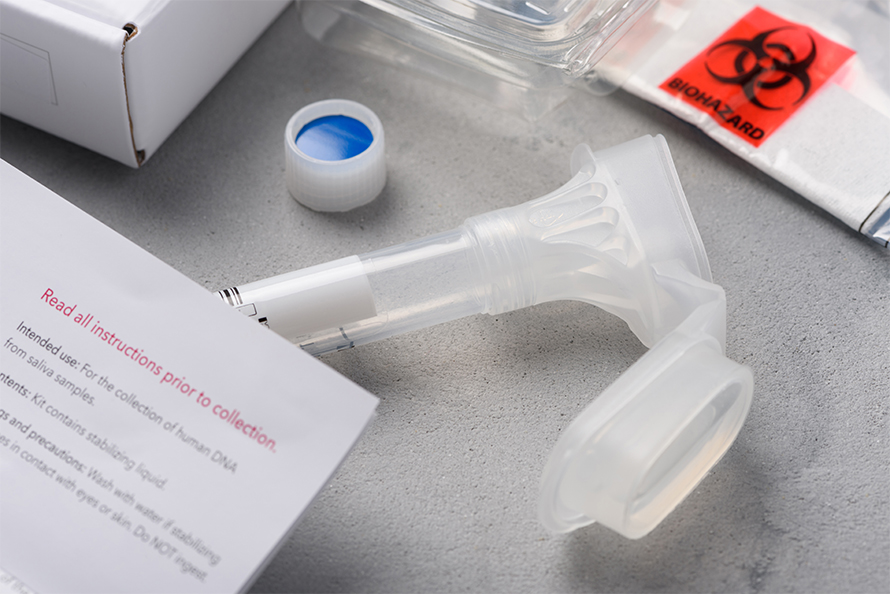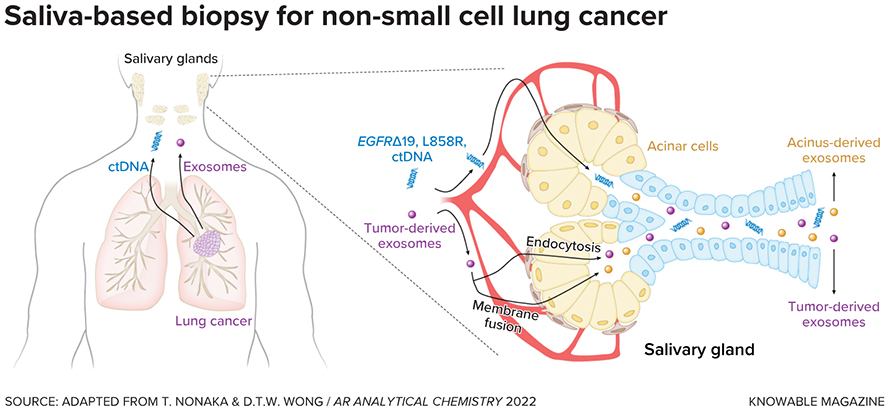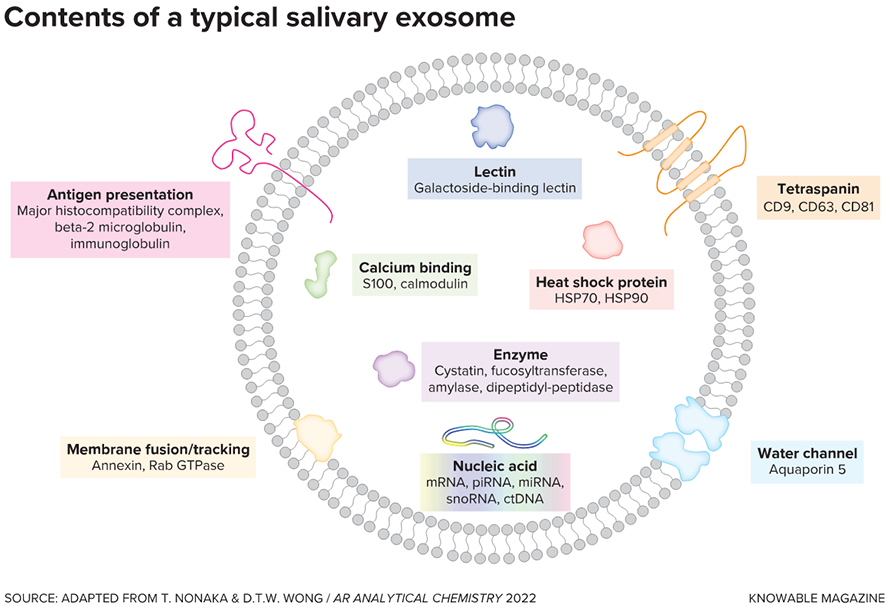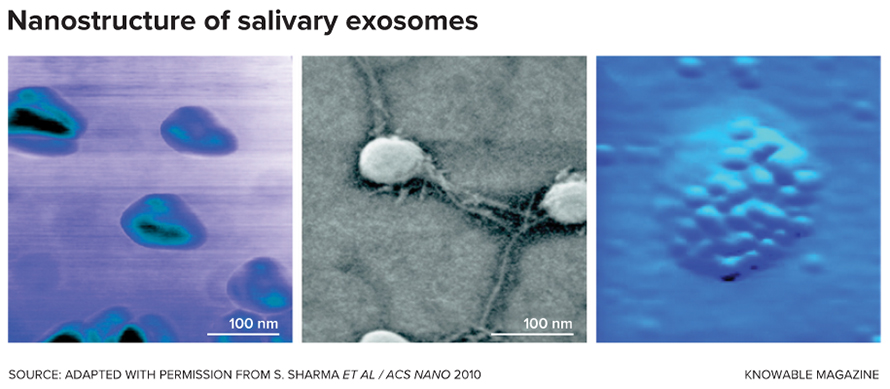Saliva: The next frontier in cancer detection
In the late 1950s, dentist and US Navy Capt. Kirk C. Hoerman, then a young man in his 30s, attempted to answer a bold question: Might the saliva of prostate cancer patients have different characteristics from that of healthy people? Could it contain traces of a disease that’s so far away from the mouth?
Without wasting more of their own saliva on elaborate discussion, Hoerman and his colleagues from the department of dental research at the Naval Training Center in Great Lakes, Illinois, got down to work. They analyzed samples from more than 200 patients and healthy controls, and found that the saliva of patients with untreated prostate cancer showed a significant increase in the levels of enzymes called acid phosphatases.
Writing in 1959 in the journal Cancer, the researchers then made a prescient reflection: that it may be valuable to observe discrete biochemical changes in tissues distant from the site of tumor origin.
More than 60 years later, the idea that saliva analysis can be used to detect different types of cancer is gaining traction in the scientific community. In the specialized literature, papers containing the keywords “diagnosis,” “cancer” and “saliva” grew more than tenfold over the past two decades, from 26 in 2001 to 117 in 2011, 183 in 2016 and 319 in 2021, according to the PubMed database, a search engine for biomedical research articles.
The appeal of this approach is obvious. Although cancer can be diagnosed through tissue biopsy, that requires trained physicians wielding long needles, scalpels, endoscopes or other tools to pry into the body to take samples. Liquid biopsy, which looks for traces of tumor components in fluids such as blood, urine, cerebrospinal fluid, semen or saliva, is a less invasive alternative. Of these, the simplest sample to collect is undoubtedly saliva.
The approach has already paid off: In 2021, the US Food and Drug Administration gave an innovative device designation to a saliva-based oral and throat cancer prediagnostic tool developed by the US company Viome. (Such designations are granted to novel medical devices that have the potential to provide more effective treatment or diagnosis of life-threatening diseases.) Based on artificial intelligence and machine learning, the tool analyzes a saliva sample for the activity of genes (in particular, messenger RNA) belonging to the bacterial community housed in the mouth. For unknown reasons, this community is modified when a tumor develops on the lips, tongue, throat or surrounding areas.
“For decades, saliva was considered a stepchild of blood,” says chemist Chamindie Punyadeera, who spent a decade working on Viome’s saliva diagnostic test. Now at Griffith University in Australia, she is lead author of a 2021 study describing the test’s development in NPJ Genomic Medicine. But that view of saliva as an afterthought could begin to change in the coming years as techniques to analyze it advance and a better understanding develops of what information it can hold. “Because saliva can be collected noninvasively, an empowered patient could take multiple samples and become a steward of his or her own diagnostic tests,” Punyadeera predicts.

The treasure contained in saliva
Every day, the salivary glands of an average adult produce between 500 and 1,500 milliliters of saliva to aid digestion and preserve oral health. In addition to enzymes, hormones, antibodies, inflammatory mediators, food debris and microorganisms, saliva has been found to contain traces of DNA and RNA or proteins from tumors.
“The goal of saliva diagnostics is to develop rapid, noninvasive detection of oral and systemic diseases,” write dental scientists Taichiro Nonaka of Louisiana State University and David T.W. Wong of the University of California, Los Angeles, in an article on saliva diagnostics published in the 2022 Annual Review of Analytical Chemistry. The field is developing rapidly due to the progress of “omics sciences” that analyze large collections of molecules involved in the functioning of an organism — such as genomics (genomes), proteomics (proteins) or metabolomics (metabolites) — as well as methods for analyzing large quantities of data. For example, the proteome of saliva — an exhaustive catalog of the proteins present in this fluid — is already available, and it is known that between 20 percent and 30 percent of the saliva proteome overlaps with that of blood.
But “the study of diagnostics through saliva is a relatively new field,” says Nonaka. It wasn’t until the last decade, he says, that it became known that salivary glands — parotid, submandibular, and sublingual, as well as other minor glands, in close proximity to blood vessels — transfer molecular information.
Today, in saliva — and also in blood — scientists are beginning to look for and find circulating tumor DNA (ctDNA), which is DNA that is shed from cancer cells when a tumor is present in the body. Multiple studies have identified biomarkers — such as proteins that are produced in higher quantities in cancer cells or genetic changes that occur in tumor cells — that could be used to detect tumors of the head and neck, breast, esophagus, lung, pancreas and ovary, as well as to monitor the patient’s response to therapies.

For example, in 2015 Chinese researchers published that the identification of two fragments of an RNA strand (microRNA) in saliva allowed the detection of malignant pancreatic cancer in 7 out of 10 patients with the disease. A more recent review of 14 studies involving more than 8,000 participants estimated that breast cancer patients were 2.58 times more likely to have certain saliva-detectable biomarkers — although 39 percent of the negative test results were in patients who actually had breast cancer. The research in the field is promising, but will require further prospective studies to determine its clinical applicability, Nonaka says.
“A great advantage of liquid biopsies is that they can sweep for up to 50 types of cancers in early stages at once, when they can be surgically treated or are candidates for short, targeted treatments,” says biologist Marina Simián, a researcher at Argentina’s National Scientific and Technical Research Council at the Nanosystems Institute of the National University of San Martín, in Buenos Aires. Simián is also cofounder of the company Oncoliq, which aims for the early detection of breast, prostate and other tumors from a blood sample.
“With today’s tools, very few organs are screened for cancer,” says Simián. Common screens include ones for prostate, breast, cervix, colon after the age of 50, and the lungs for those who have smoked heavily. And in the world, she says, only half of these people undergo these tests, and in many countries, not even 10 percent. The hope is to add many more tests that can be done on a single blood or saliva sample.
It is possible that in the future, testing of both blood and saliva will be the norm. Although there is still a long way to go, Nonaka believes that, except for oral cancers, saliva testing should most likely be supplemented with liquid biopsies in blood or urine, plus other parameters to increase sensitivity and practical utility.
In pursuit of exosomes
One particularly promising type of component to look for in saliva is the exosome. Exosomes are tiny lipid-wrapped vesicles that are present in almost all types of body fluids. They are transporters or messengers that travel from one cell to another — even to those in very distant organs. They carry a cargo of genetic material and proteins, which is taken up by a recipient cell in an organ and plays important roles in cell-to-cell signaling. But exosomes also have an important role in cancer. “They are key players,” says Punyadeera. Released by cancer cells, they pass into the blood and from there, can reach the salivary glands. The exosomes are thus dumped into the saliva, from which they can be collected.

Exosomes from tumor cells have a specific composition and are suspected of contributing to the spread of cancer to other organs or tissues. But from a diagnostic perspective, one of their main advantages is that they package and protect the cargo — in other words, they do not mix with the other components of saliva. In this way, they provide “more stable and accurate clinically relevant information for disease detection,” Nonaka explains.
For example, for squamous cell esophageal cancer, scientists have found two signatures or signals in salivary exosomes that allow detection of this disease with a sensitivity and specificity of more than 90 percent, in addition to providing guidance on prognosis and treatment, as reported in January 2022 in Molecular Cancer.
Factors such as the concentration or appearance of exosomes under the microscope can also be revealing. Patients with oral cancer, for example, have exosomes with different shapes and sizes than those found in healthy individuals.
However, the techniques available so far to isolate and study the exosome content of saliva are expensive and laborious. In response to this challenge, a new method known as electric field-induced release and measurement, or EFIRM, has emerged; it integrates electrochemical sensors and magnetic fields to elegantly capture minute amounts of circulating tumor DNA and other molecules — biomarkers — that indicate the presence of cancer. This technique has already shown encouraging results in the early detection of non-small cell lung cancer and could also be used to assess response to treatment.

The US company Liquid Diagnostic LLC, in which Wong has a stake, already offers this technology, having christened it Amperial and promising “the highest specificity and sensitivity for early stage cancers” and at “much lower cost.” Those most enthusiastic about the technology propose a world where a routine visit to the dentist saves lives and it is not necessary to draw blood to check if someone is ill. But experts agree that, for that dream to become a reality on a large scale, more studies are still needed.
“To achieve the translation of salivary biomarkers to the clinic, it is necessary, on the one hand, to develop standardized protocols and, on the other, to carry out large multicenter studies in which the influence of different confounding variables such as age, sex or lifestyle is analyzed,” says dental scientist Óscar Rapado González, of the Health Research Institute of Santiago de Compostela, in Spain, where he is investigating the use of saliva samples for the detection of head and neck cancers, as well as colorectal tumors.
The identification in saliva or other fluids of molecules directly or indirectly related to tumors has potential apart from early detection, says Rapado González. It might make it possible to assess individual risk of developing cancer, predict how a tumor will evolve or monitor the therapeutic response in a noninvasive way, allowing the development of personalized medicine.
“Undoubtedly,” Rapado González says, “more research in this field will drive progress toward the applicability of saliva in precision oncology in the coming years.”
This article originally appeared in Knowable Magazine, an independent journalistic endeavor from Annual Reviews.
Enjoy reading ASBMB Today?
Become a member to receive the print edition four times a year and the digital edition monthly.
Learn moreGet the latest from ASBMB Today
Enter your email address, and we’ll send you a weekly email with recent articles, interviews and more.
Latest in Science
Science highlights or most popular articles

Bacteriophage protein could make queso fresco safer
Researchers characterized the structure and function of PlyP100, a bacteriophage protein that shows promise as a food-safe antimicrobial for preventing Listeria monocytogenes growth in fresh cheeses.

Building the blueprint to block HIV
Wesley Sundquist will present his work on the HIV capsid and revolutionary drug, Lenacapavir, at the ASBMB Annual Meeting, March 7–10, in Maryland.

Gut microbes hijack cancer pathway in high-fat diets
Researchers at the Feinstein Institutes for Medical Research found that a high-fat diet increases ammonia-producing bacteria in the gut microbiome of mice, which in turn disrupts TGF-β signaling and promotes colorectal cancer.

Mapping fentanyl’s cellular footprint
Using a new imaging method, researchers at State University of New York at Buffalo traced fentanyl’s effects inside brain immune cells, revealing how the drug alters lipid droplets, pointing to new paths for addiction diagnostics.

Designing life’s building blocks with AI
Tanja Kortemme, a professor at the University of California, San Francisco, will discuss her research using computational biology to engineer proteins at the 2026 ASBMB Annual Meeting.

Cholesterol as a novel biomarker for Fragile X syndrome
Researchers in Quebec identified lower levels of a brain cholesterol metabolite, 24-hydroxycholesterol, in patients with fragile X syndrome, a finding that could provide a simple blood-based biomarker for understanding and managing the condition.

